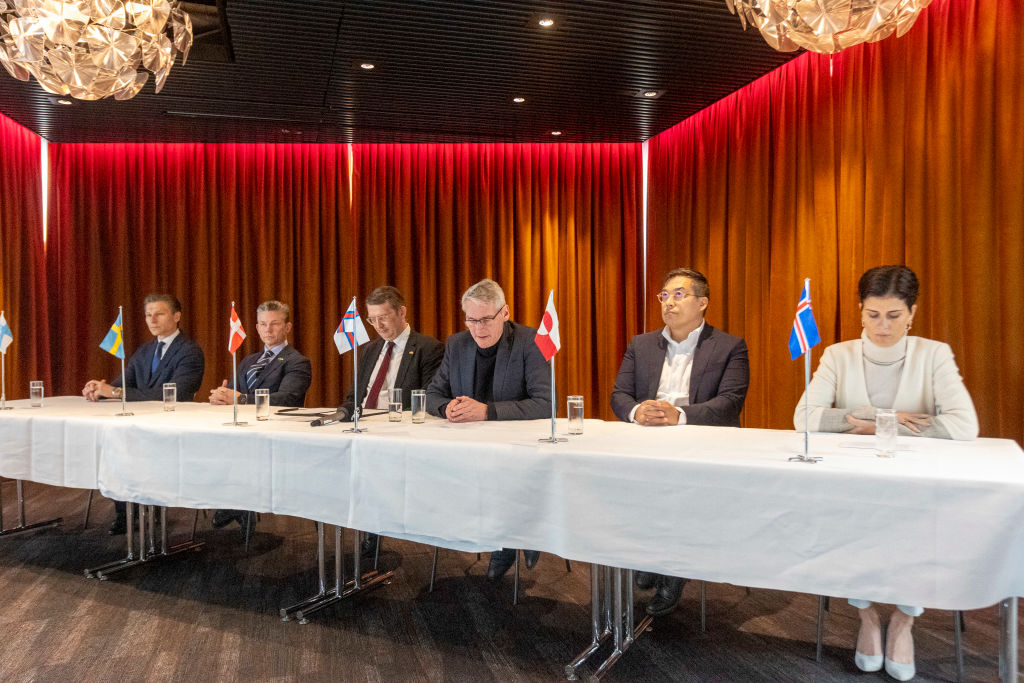Nordic defense ministers gather in the Faroe Islands in April 2024 to discuss military cooperation. AFP/GETTY IMAGES
THE WATCH STAFF
Nordic prime ministers and defense ministers met in Stockholm in September 2024 to agree that Sweden would assume the leadership of NATO’s forward presence on its northeastern flank. The location of the forward presence remains undecided, but Finland’s Lapland region is believed to be the leading candidate to host the new NATO structure, according to The Barents Observer, a Norwegian newspaper. The plan isn’t to station NATO troops permanently in the area, but the base would be staffed by command officers in charge of deploying forces.
“This is a major new step in the defence relationship between our countries. Finland and Sweden are now allies. Together, we make NATO stronger and make a strong contribution to the development of NATO’s collective deterrence and defence,” said Finnish Defence Minister Antti Häkkänen, The Barents Observer reported.
Since Russia invaded Ukraine in February 2022, Finland and Sweden have joined NATO and beefed up their defense budgets, as have their Scandinavian neighbors, Denmark and Norway. Later in September, Canadian Foreign Minister Mélanie Joly convened Nordic foreign ministers in New York and Canada’s Far North to work out a structure of regular security and defense talks between Canada and the Nordic NATO members, including Iceland. The increasing collaboration of NATO allies in the Arctic will be a central focus of the group, which will also focus on economic development and investing in Indigenous communities.
Russia has traditionally ascribed great strategic importance to its Arctic territory — its Northern Fleet is based in the Kola Peninsula, and Moscow plans to establish new brigades in Karelia, a border region with Finland. In light of the developments, in Stockholm in September 2024 Sweden and Finland held their first one-on-one high-level summit since 2009. In a joint declaration, the governments reaffirmed their steps toward closer integration and decided that establishing an east-west transportation and communications corridor would serve both civilian and military purposes.
“Both countries see a need for further co-operation between all the Nordic countries in the areas of transport and energy. The infrastructure in a west-east direction between our countries needs to be developed for both civilian and military purposes, with the goal of creating transport routes from Norway through Sweden to Finland in the longer term. Finland and Sweden will work together to steer investments from the Nordic Investment Bank (NIB) and the Nordic Environment Finance Corporation (NEFCO) towards strategic investments and projects that benefit competitiveness and the green transition. Closer bilateral cooperation on cross-border issues, the High North and the Arctic cross-border issues, the High North and the Arctic, there are concrete opportunities for cross-border cooperation,” the joint declaration read.
Recent developments in the Nordic region were analyzed in an October 2024 report from the Carnegie Foundation for International Peace, which concluded that Nordic NATO members play a key role in the military alliance’s “Enhanced Forward Presence” from the Baltic countries to the Black Sea. Under this plan, “forward land forces” will function less as trip-wire forces than capable defense forces able to rapidly confront aggression and ready to rapidly integrate up to 180,000 reinforcement troops within a few months. “This evolution is in line with a general turn in the alliance toward deterrence by denial, where eventual Russian aggression toward a NATO country is supposed to be forcefully confronted and immediately stopped,” the report stated.

